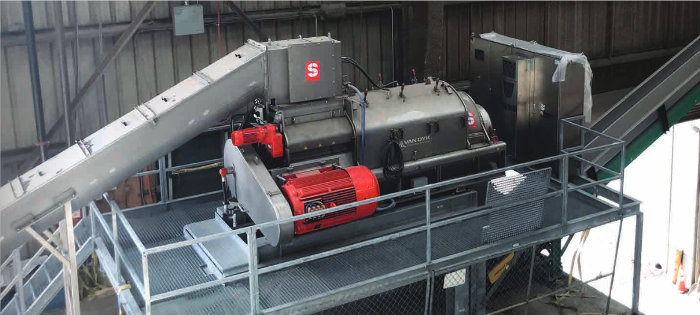 by Florian Eenkema van Dijk, Sales & Special Projects, Van Dyk Recycling Solutions
by Florian Eenkema van Dijk, Sales & Special Projects, Van Dyk Recycling Solutions1. Why add a food depackaging system to my operation?
Depackagers take packaged food waste and liberate the organics, creating a purified organic slurry and pressing the discarded packaging fraction for a maximum recovery of organics. A robust depackager achieves capacity in excess of 18-20tph, a higher recovery of organic material with increased purity, faster unloading times, and helps you comply with state mandates (like SB 1383) for organic recovery and diversion from landfill. Accepted materials include pre-consumer packaged food waste, pre-consumer mixed source separated organics, post-consumer food waste, supermarket and restaurant waste, frozen foods, beverage cartons and bottles, and canned food and beverages. With a depacking system you won’t have to turn away additional organic tonnage that’s wrapped in packaging!
![]()
2. What are the different kinds of food depackagers?
Manufacturers use either a horizontal design or a vertical design. A vertical design allows gravity to feed the unit via a feedhopper, creating a compact and inexpensive feed system. Horizontal designs use feed systems requiring slightly more space. An inground feed hopper system blends and stores a variety of bulk materials, which are then conveyed to the depackager. Horizontal depackagers are more suited to high-capacity operations receiving bulk items and are easily fed by a loader or by collection trucks dumping directly into the bunker.
3. What are the advantages of the horizontal depackager?
As mandates for organics recycling become widespread, contamination levels in SSO material will increase. This is problematic for vertical depackagers, as heavy non-organic contaminants are not easily ejected vertically. Capacity and screening surface is limited, losing more organics to residue. Horizontal depackagers easily eject heavy contamination and a gentler hammermill design can be used with flexible hammers that spin at a much lower rpm. A large, rotating 360° screen results in a higher throughput with limited downtime, a minimal amount of organics lost in the residue and very few microplastics in the organics.
4. Do I need an upfront shredder or presort station?
Depending on inbound SSO contamination rates, mechanically removing oversized residue/film prior to the depackager can be beneficial. The SMICON depackager system does not require presorting and is able to handle the wide array of non-organic residue seen in SSO material. Basic floor sorting by the materials handler or loader is sufficient, and problematic items can be identified on the tipping floor to be crushed or removed before entering the depackager.

5. What are the end markets for this material?
The organic slurry or “cake” (depending on moisture levels) can be sold to composting, sewage treatment, animal feed operations, or anaerobic digestion companies for recycling or waste-to-energy. Each end market has different purity and moisture requirements. Contact Van Dyk for more information.
